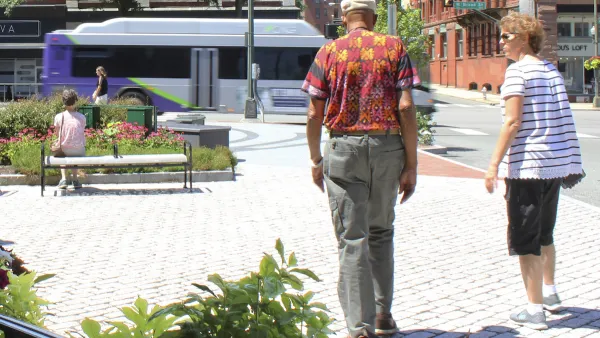Time's environmental reporter examines the American neighborhood with help from New Urbanist founder Andres Duany, who comments on suburbia and its carbon footprint, the role of the car, home size, public space, and ratings of green building.
"The dominant pattern of development in America -- large houses and sprawling, auto-dependent suburbs - require a heavy input of fossil fuels and an output of carbon emissions. The adoption of cleaner technologies will take us part of the way, but what we really need to do is change our habitat, not just for the environmental benefits, but for our health, lifestyle and happiness.
Duany and his peers in New Urbanism want to stem suburban sprawl in favor of medium-density towns and neighborhoods where houses, offices, shopping and leisure activities would all be within a walkable space. The automobile - which is responsible for a significant portion of most Americans' individual carbon footprint - would become an option, not a lifeline. "This goes beyond simply having cars that will pollute less, like hybrids," says Duany, a voluble 58-year-old who grew up in Cuba before moving to the U.S. in 1960. "It means not having to drive."
"What is causing global warming is the lifestyle of the American middle class," says Duany. "It's terrible for nature and for humans."
The explosion of the American house - up from 1,385 sq. ft. on average in 1972 to 2,140 sq. ft. in 2000, while the average number of people living in it has decreased - is, in Duany's view, a consequence of our practice of virtually eliminating the public space outside of major urban areas. "What has blown up the McMansions is the lack of community," says Duany. "We need to externalize those social needs, rather than privatizing them."
"It's important to note that New Urbanism is different from green building, that other environmental trend that's never far from the news. For better or worse, environmental design has come to be defined by the U.S. Green Building Council's Leadership in Energy and Design (LEED) ratings . A design could win a Platinum LEED rating - the highest possible award - but it can't really be described as environmentally friendly if it's part of a sprawling neighborhood that just adds to car dependency. "It doesn't matter how green you are if your house in the suburb still generates 14 car trips a day, which is the American average," says Duany."
Thanks to Martin Dreiling
FULL STORY: Going Green - How Green is Your Neighborhood?

Planetizen Federal Action Tracker
A weekly monitor of how Trump’s orders and actions are impacting planners and planning in America.

Vehicle-related Deaths Drop 29% in Richmond, VA
The seventh year of the city's Vision Zero strategy also cut the number of people killed in alcohol-related crashes by half.

As Trump Phases Out FEMA, Is It Time to Flee the Floodplains?
With less federal funding available for disaster relief efforts, the need to relocate at-risk communities is more urgent than ever.

More Apartments Are Being Built in Less-Dense Areas
Rising housing costs in urban cores and a demand for rental housing is driving more multifamily development to exurbs and small metros.

Plastic Bag Bans Actually Worked
U.S. coastal areas with plastic bag bans or fees saw significant reductions in plastic bag pollution — but plastic waste as a whole is growing.

Improving Indoor Air Quality, One Block at a Time
A movement to switch to electric appliances at the neighborhood scale is taking off in California.
Urban Design for Planners 1: Software Tools
This six-course series explores essential urban design concepts using open source software and equips planners with the tools they need to participate fully in the urban design process.
Planning for Universal Design
Learn the tools for implementing Universal Design in planning regulations.
Borough of Carlisle
Smith Gee Studio
City of Camden Redevelopment Agency
City of Astoria
Transportation Research & Education Center (TREC) at Portland State University
Camden Redevelopment Agency
City of Claremont
Municipality of Princeton (NJ)


























